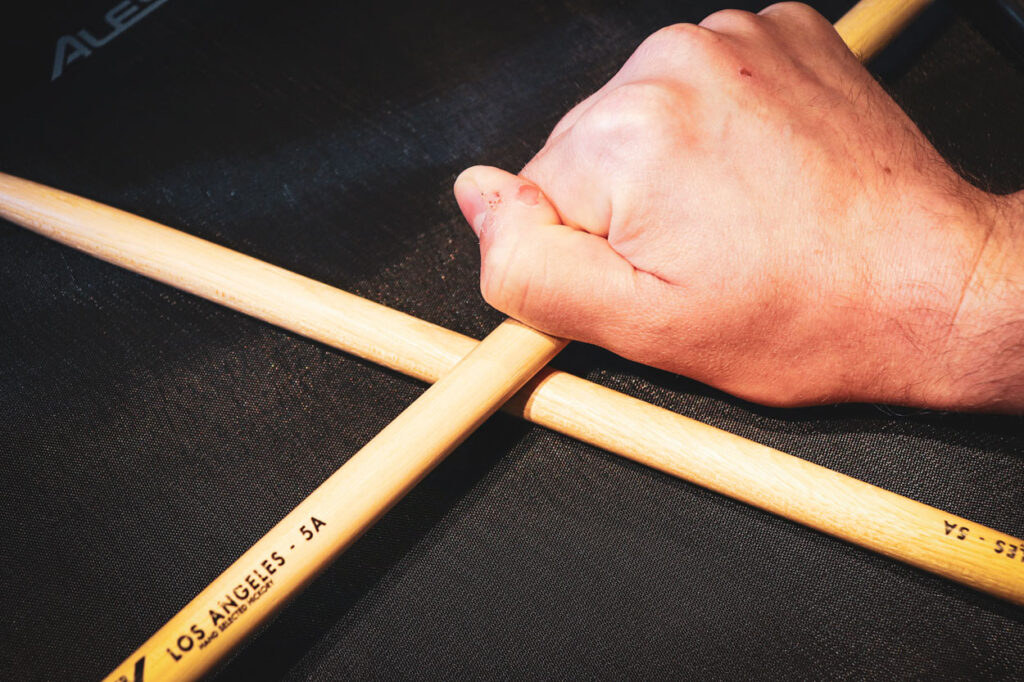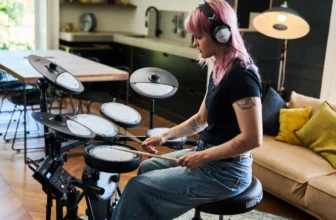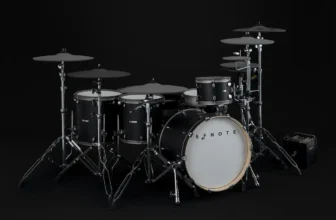

As I discussed in my previous article, drumming can be a serious workout, and poor technique and repetitive motion can lead to short and long-term injuries, aches, and pains.
Casually drumming a few times a month is unlikely to raise your risk of serious injury, and most injuries are from practicing or performing regularly.
Many of the injuries I will go over below fall into the category of repetitive strain injuries caused by inflammation, damage, and stress against your muscles, tendons, and nerves.
Repeat strain on the muscle or tendon can cause tiny micro-tears in the tissue, and the body will try to repair these tears, ultimately making you stronger.
However, sometimes the tears are made faster than the body can heal them, and as the number of tears increases, they can cause pain from inflammation, weaken the tendon, and cause larger tears in the tissue.
This leads to various forms of tendonitis or muscle pain. The good news is most of these can be avoided or resolved with proper rest and adequate stretching.
Fingers, Hands & Wrists
The smaller muscles of the hands, fingers, and wrists are highly complex systems that allow humans the dexterity and adaptability to perform thousands of tasks daily. This includes the nuanced dynamics, and intense drumming speeds the less agile forearms, triceps, and shoulders cannot provide.
While an entire article could be spent on the muscles on the hand and wrists and their implications on drumming, I’ll try to hone in on the highlights.
Wrist Pain
Wrist pain can appear in many forms, including the ones mentioned below, but can most commonly occur when you jerk or “tweak” your wrist in an uncomfortable position while playing, causing strain or damage to one of the small tendons, muscles, and bones within the wrist.
Additionally, repeated heavy hitting of the drums, especially with excessive rimshots with poor technique, can lead to stress and impact injuries such as tendonitis and even stress fractures.
Wrist Tendinitis
Wrist Tendinitis is inflammation in the tissues of your wrist that connect your forearm muscles to bones in your hand. This is an inflammation of the tendons and is often caused by overuse of the wrist and forearm muscles.
Symptoms include pain, swelling, and stiffness. Wrist tendonitis can come in many forms, but the most common variations occur on tendons near your thumb and pinkie finger.
Carpal Tunnel Syndrome
Carpal tunnel syndrome is caused by pressure on the median nerve, which runs from your forearm through the wrist into the palm of your hand. Because of the repeated strain on the wrist with drumming, especially with poor technique and grip technique, can cause this pressure, leading to pain, numbness, and weakness in the hand and wrist.
Hand and Thumb Cramping
Hand and thumb cramping and grip injuries or pain are often the result of poor technique, lack of relaxation, or lack of grip strength. If your hand is cramping before your grip gives out, you need to train your grip to withstand the physical demands of your playing.
Adequate stretching before and after a drumming session can also help avoid this, but nothing will help you more than focusing on strengthening your hands.
Blisters

Blisters and hand cramping fall into the same injury category as they are most often related. While blisters are usually the first stepping stone into forming good and functional callouses (which protect your hand from more blisters!), they generally occur from poor grip technique or damp conditions.
If your palms are damp or sweaty during a drumming session, the friction caused by the drumsticks against your skin is the perfect breeding ground for a new blister. If you’re worried about this, you can always carry a small towel or rock climbing chalk in your drumstick bag.
Elbows & Shoulders
The fascinating thing about drumming is that because it mimics many movements found in common sports, many of the injuries to the elbow and forearm are similar to those athletes will face and will primarily be related to overuse.
Tennis Elbow
Tennis elbow is a form of tendonitis that causes pain over the bony prominence on the outside of the elbow. This area is responsible for extending or bending back the wrist and fingers.
This can cause pain on the outside of the forearm below the elbow but can also cause pain to radiate down the forearm. This is where training to have a firm grip is essential, as tennis elbow is more prone to occur when straining your grip repeatedly while bending your wrist backward, which is common in drumming.
Golfer’s Elbow
Golfer’s elbow is similar to tennis elbow, but instead causes pain where the tendons of your forearm attach to the bony bump on the inside of your forearm below the elbow.
The most common symptom is pain along the palm side of the forearm, from the elbow to the wrist, on the same side as the pinky finger. The pain can be felt when bending the wrist toward the palm against resistance or squeezing a rubber ball.
Weightlifter’s Elbow
Tricep tendonitis (Weightlifter’s elbow) tends to be the one I suffer from most. Extended sessions of drumming coupled with a regular weightlifting program or a job or hobby that requires the engagement of the triceps (think construction, cycling, throwing movements) can cause pain in the back of the elbow up the back of your arm.
Shoulder Pain
Shoulder pain when drumming is tricky to diagnose as the problem is often not caused directly by the shoulder unless you specifically have an injury to the rotator cuff or deltoid muscles.
Instead, shoulder pain is most likely from bad posture or hunched shoulders that pinch a nerve or muscle in the shoulder, issues at the elbow since many of the elbow muscles connect at the shoulder, or poor grip, which can cause elbow pain that radiates up the arm.
While your impulse may be to treat your shoulder pain directly, it’s essential to consider that it may result from pain radiating to your shoulder from one of those other regions.
Head & Neck
Head and neck problems behind the drums are most often the result of bad posture. For example, hunching over your drums instead of sitting upright can lead to pinched nerves in your neck, radiating into your shoulder blades and midback.
Also, aggressively moving your head back and forth or throwing your head around to the beat for extended periods can lead to neck pain, disc injuries, and even temporary vertigo. But one of the most critical injuries to avoid when drumming is hearing damage, which I will be grouping into this category.
Hearing Damage
Turning the drums down is difficult, especially when your music requires you to play intensely or at higher volumes. Hearing damage and tinnitus from constant exposure to drumming or loud music can be permanent if not addressed early on.
I have suffered from tinnitus for nearly two decades despite having ‘normal’ hearing, per my most recent hearing test in 2022.
The modern world is loud, especially if you live in a city, and by now, many of us have left a noisy concert, club, or bar with our ears ringing.
If you consider the constant onslaught of noise we deal with upon leaving our homes, add listening to music through headphones or earbuds and then drumming on top of that, and your ears are taking in some serious dBs over the course of your day.
While your ears can heal themselves, the rate at which they do so is determined by genetics, diet, overall health, and stress level.
However, hearing damage becomes permanent if the ears don’t have the time or resources to repair themselves. While a single loud event may cause immediate harm, most hearing damage accumulates from these minor events over time.
Back & Legs
Chronic back pain, often linked to slouching, is most commonly seen in players who sit either too high or too low behind their drums.
The most prominent example of this has been Phil Collins, who claimed that his poor posture behind the drums led to debilitating spine and neck issues that have left him unable to drum on top of an overall decrease in his quality of life.
Knee Pain
Drumming from a seat that is too low can also lead to knee pain, as sitting too low puts your knees at a mechanical disadvantage.
Adjusting your throne, so your hips are higher than your knees gives you a mechanical advantage over your pedals and prevents strain on your lower back and hips when lifting your legs or feet to use your pedals. You should also have your ankle slightly in front of your knee to open up the range of motion to the ankle.
Leg Pain
Similar to many of the injuries we’ve discussed, back and leg pain while drumming often results from environmental factors or the overall ergonomics of your drumset.
The key is to continually adjust your drum setup to fit your body best and maintain an athletic mindset about how you approach your drums to avoid these injuries in the first place.
How To Prevent Drumming Injuries
First and most importantly, ear protection is essential, and hearing tests are necessary every year or two if you are drumming regularly. Thankfully, these days, hearing protection is better than ever.
You have many options, from over-the-ear headphones to sound isolation headphones to custom in-ears to custom molded earplugs to even those regular foam earplugs you can use.
Even shoving tissue is better than nothing. The key is to augment the noise below a level that would be damaging if sustained for hours.
Next, perfecting your drumming technique should be a lifelong journey that adjusts to your body’s needs. Since everyone’s body is different, you can’t expect another drummer’s technique to mesh with the needs of your physicality perfectly. You should choose what works best to see if it makes your playing experience more comfortable.
Stretching your fingers, wrist, arms, and calf muscles should become essential to your drumming recuperation. A simple 5-minute routine of finger, wrist, and ankle stretches can help prevent days and weeks of injuries. Remember: lengthening is strengthening, meaning the more consistently you stretch out these muscles, the more likely you will get stronger.
Warming up your body before playing will also become more and more necessary, especially as you age or if your gig becomes more physically demanding.
All professional drummers taking the stage before a large audience prepare their bodies beforehand. Whether jumping rope or practicing on a drum pad, the key to warming up is promoting blood flow throughout your body.
Maintaining a solid posture and strengthening your back muscles is a lesson you can apply to drumming and life. Nothing in life will be diminished from standing up straighter or having a stronger back.
It would be best if you also exercised the antagonistic movement patterns to drumming with some resistance exercise at least once a week. Whether you use weights, bands, water bottles, or your body weight, you must perform movements opposite to your drumming movements, especially if you’ve played the drums for many years.
This includes bicep curl variations to counter the excessive work of the triceps; deltoid raises to counter the downward swinging of the delts; back exercises such as rows, rear delt rows, rhomboid rows, and others to strengthen the support muscles of the upper back and spine to maintain stability and a solid upper back posture while playing especially throughout a long session.
Setting up your drums ergonomically is just as important as making them look great when set up. Your drums should be set up at the perfect crossroads of coolness, practicality, and comfort if you expect to play long-term and move fluidly around the kit. Conversely, no one will care how cool you look behind your drums if you can’t play them properly.
Lastly – and this is certainly not a complete list – moisturizing your hands, especially if you live in a dry climate or are prone to dry skin, is essential to protect your hands, save your callouses, and prevent blisters.
Dry hands will crack easier, leading to a diminished grip as drumsticks tend to enjoy a supple bed of skin to move against. But, again, this is best done before bed so the moisturizing cream can settle into your hands while you sleep.
No matter how prepared you are, injuries will ultimately happen. The best thing you can do is prepare for them and know what to do to recuperate quickly when they do.





All that talk of strengthening your upper back but no mention of strengthening your abs(specifically the transverse abdominus) which protect the lower back.